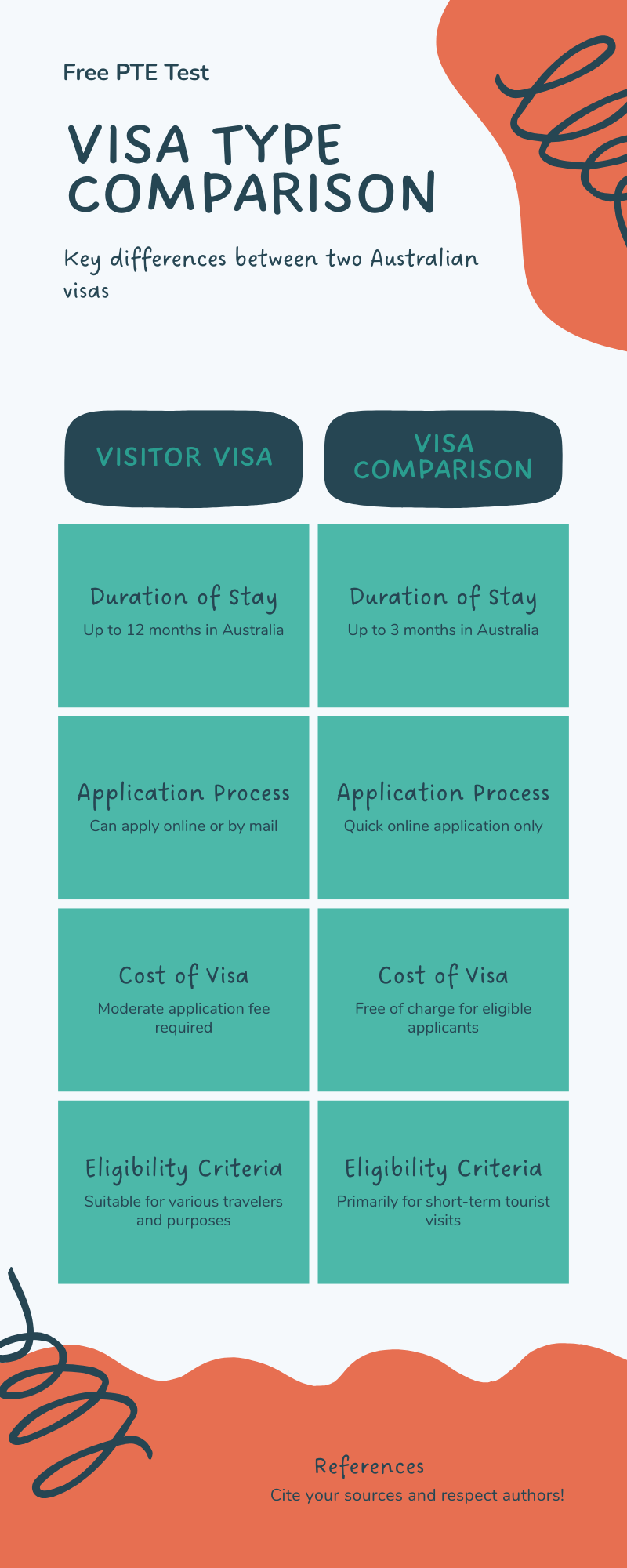Tourist Visa vs Visitor Visa: Australia, with its stunning landscapes, vibrant cities, and rich cultural tapestry, attracts millions of visitors annually.
Whether you’re dreaming of snorkeling on the Great Barrier Reef, exploring the Sydney Opera House, or reuniting with family Down Under, securing the right visa is essential.
Two popular options for short-term stays are the Visitor Visa (Subclass 600) and the eVisitor Visa (Subclass 651). Often confused as “tourist” versus “visitor” visas, these are tailored for tourism, business, or family visits but differ significantly in eligibility, costs, duration, and application processes.
As of October 2025, recent updates from the Department of Home Affairs include fee adjustments effective from July 2025, streamlined digital processing tools for faster approvals, and enhanced biometrics requirements for certain applicants.
These changes aim to improve efficiency amid rising global travel demand. This in-depth article explores both visas, their types and subtypes, eligibility criteria, application steps, costs, and key differences—equipped with tables for clarity.
By the end, you’ll know which visa suits your needs, ensuring a hassle-free journey to the Land of Oz.
Understanding the Visitor Visa (Subclass 600): An Overview
The Visitor Visa (Subclass 600) is a versatile temporary visa designed for individuals wishing to visit Australia for short-term purposes. It replaced earlier tourist visas and is open to applicants from all nationalities, making it the go-to option for diverse travelers.
Unlike more restrictive electronic visas, Subclass 600 allows for longer stays and specialized streams to match specific visit intents.
Granted either outside or inside Australia (depending on your current status), this visa emphasizes the “Genuine Temporary Entrant” (GTE) criterion: you must prove your primary intent is to visit temporarily and return home afterward.
Key benefits include flexibility in duration and the ability to apply onshore for extensions in some cases. However, it requires a fee and thorough documentation.
As per the latest updates in October 2025, the Department of Home Affairs introduced a fast-track processing option for Tourist Stream applications, reducing wait times by up to 50% for complete submissions.
Additionally, visa fees saw a modest increase from July 1, 2025, to account for inflation and administrative costs.
Types and Subtypes of Subclass 600: Detailed Breakdown
The Subclass 600 is divided into four primary streams, each with subtypes tailored to specific scenarios. Below, we delve into each, including eligibility, duration, and unique features.
- Tourist Stream
This is the most common subtype, ideal for leisure travelers, family reunions, or cruises. It allows pure tourism without work or study (beyond incidental short courses).
- Eligibility: Open to all nationalities. You must demonstrate strong ties to your home country (e.g., job, family, assets), sufficient funds (at least AUD 5,000 per month of stay plus return flights), and meet health/character checks. No invitation letter is mandatory, but it’s recommended for family visits.
- Duration: Up to 3, 6, or 12 months per stay; single or multiple entries possible.
- Subtypes:
- Standard Tourist: General tourism; processing time: 75% within 20 days, 90% within 33 days (as of early 2025).
- Approved Destination Status (ADS) Stream: Exclusive to Chinese citizens/permanent residents under the Australia-China tourism agreement. Requires group travel via approved operators; fee AUD 150; up to 3 months multiple entries within 12 months.
- Application Notes: Apply online via ImmiAccount. Biometrics may be required for high-risk nationalities.
- Business Visitor Stream
Geared toward professionals attending conferences, meetings, or exploratory business (no paid work in Australia).
- Eligibility: Prove business intent with itineraries, invitations from Australian entities, and financial proof. Same GTE, health, and character rules apply.
- Duration: Up to 3 months; single entry typically.
- Subtypes:
- Short Business Visits: For meetings or negotiations; processing: 9-20 days.
- Professional Development: Includes training under 3 months; no hands-on work.
- Key Restriction: Cannot sell goods, perform paid services, or establish business operations.
- Sponsored Family Stream
For visiting close relatives (spouse, children, parents) with financial sponsorship from an Australian citizen/permanent resident.
- Eligibility: Sponsor must be eligible (e.g., no outstanding debts to immigration) and provide a bond (up to AUD 15,000, refundable if conditions met). Applicant needs family ties proof and funds.
- Duration: Up to 12 months; multiple entries.
- Subtypes:
- Family Reunion Visits: Standard family stays; processing: 50-70 days due to sponsorship checks.
- Medical Treatment Accompaniment: If accompanying a family member for treatment; requires medical evidence.
- Updates: As of March 2025, exemptions for substituted Subclass 600 were introduced for certain parent visa applicants, easing transitions.
- Frequent Traveller Stream
Aimed at regular visitors (e.g., business executives or family with ongoing ties).
- Eligibility: History of multiple Australian visits; strong evidence of ongoing reasons (e.g., business contracts).
- Duration: Up to 12 months validity with unlimited entries, but each stay ≤3 months.
- Subtypes: Primarily for business-family hybrids; no distinct subtypes, but overlaps with other streams.
- Processing: Similar to Tourist (20-33 days).
Stream | Primary Purpose | Max Stay per Visit | Entry Type | Processing Time (2025) | Fee (AUD, Oct 2025) |
Tourist | Leisure/Family | 3-12 months | Single/Multiple | 20-33 days | 190-200 |
Business Visitor | Meetings/Conferences | 3 months | Single | 9-20 days | 200 |
Sponsored Family | Family Visits | 12 months | Multiple | 50-70 days | 365 (incl. sponsorship) |
Frequent Traveller | Regular Visits | 3 months (unlimited entries) | Multiple | 20-33 days | 200 |
*Table 1: Subclass 600 Streams Comparison (Fees updated July 2025; onshore applications +AUD 25-100 extra).

Exploring the eVisitor Visa (Subclass 651): An Overview
The eVisitor (Subclass 651) is a free, electronic visa for short-term visits, electronically linked to your passport—no stamps or labels needed. Launched to simplify travel for European nations, it’s perfect for spontaneous trips. Unlike Subclass 600, it cannot be extended onshore, but you can apply for a new one post-expiry.
As of June 2025, the visa remains free with no fee hikes, and processing is instantaneous for most (under 24 hours). A key update: Enhanced integration with the Visa Entitlement Verification Online (VEVO) system for real-time status checks.
Types and Eligibility for Subclass 651
Unlike Subclass 600’s streams, Subclass 651 has no subtypes—it’s a single-category visa for tourism or business visitors. However, it implicitly supports family visits if tied to tourism.
- Eligibility: Restricted to citizens of 34 eligible countries (mostly EU members + Andorra, Iceland, Liechtenstein, Monaco, Norway, San Marino, Switzerland, Vatican City). You must:
- Hold a valid passport from an eligible nation.
- Intend tourism, visiting friends/family, or business (no paid work).
- Meet health requirements (no active TB; no Medicare coverage unless reciprocal agreement).
- Satisfy character checks: No criminal convictions totaling 12+ months imprisonment (if so, apply for Subclass 600 instead).
- Prove GTE and sufficient funds (AUD 1,000-5,000 recommended).
- Duration: Multiple entries; up to 3 months per visit within 12 months from grant date.
- Key Features: Free application; no work/study allowed; cannot include dependents (apply separately).
- Ineligible Passports: British National Overseas or similar non-citizen UK passports.
Criterion | Subclass 651 Requirement | Notes (2025) |
Nationality | 34 specific countries (e.g., Austria, France, Germany) | Full list on immi.homeaffairs.gov.au |
Purpose | Tourism/Business Visitor | Family visits OK if incidental |
Health/Character | Standard checks; no serious convictions | TB screening for long stays |
Funds | Self-supporting | Bank statements advised |
Processing | Instant to 2 days | Online only |
Table 2: Subclass 651 Eligibility Essentials.
Key Differences: Tourist Visa (Subclass 600) vs eVisitor (Subclass 651)
While both facilitate short stays, their contrasts are stark—especially for non-Europeans.
Aspect | Subclass 600 (Visitor) | Subclass 651 (eVisitor) |
Cost | AUD 190-365 (stream-dependent) | Free |
Eligibility | All nationalities | 34 European countries only |
Max Stay | Up to 12 months | 3 months per visit |
Entries | Single or multiple | Multiple (12-month validity) |
Extension | Possible onshore | Not possible; reapply after expiry |
Purpose Flexibility | Tourism, business, family (streams) | Tourism/business only |
Processing Time | 9-70 days | Instant-2 days |
Work Allowed | No | No |
*Table 3: Head-to-Head Comparison (October 2025 Updates).
Subclass 600 suits longer, sponsored, or non-European trips, while 651 is ideal for quick, cost-free European jaunts. Overstaying either risks future bans—651 overstays over 28 days trigger interviews.
Application Process: Step-by-Step Guide
For Subclass 600
- Assess Eligibility: Use Visa Finder on immi.homeaffairs.gov.au.
- Gather Documents: Passport, photos, financials, itineraries, GTE statement (500+ words).
- Create ImmiAccount: Online portal; select stream.
- Submit & Pay: Upload docs; pay fee. Biometrics at VFS Global if required.
- Track & Travel: VEVO check; grant letter emailed. Onshore tip: If in Australia on another visa, apply before expiry.
For Subclass 651
- Check Passport: Confirm eligibility.
- ImmiAccount Setup: Minimal docs (passport scan).
- Apply Online: Free; answer health/character questions.
- Instant Approval: Email confirmation; print for travel.
- Entry: Border Force verifies via passport chip.
Both processes are digital-first, with 2025 enhancements like AI-assisted GTE reviews speeding things up.
Costs, Validity, and Latest Updates (October 2025)
- Costs: Subclass 600: Base AUD 190 (Tourist), up to 365 (Sponsored); +AUD 475 onshore. Subclass 651: Nil, but travel insurance recommended (AUD 50-200/month).
- Validity: 600: Stream-specific (3-12 months); 651: 12 months from grant.
- Updates:
- July 2025: Fee hikes (e.g., 600 up 3-5%).
- October 2025: Fast-track for 600 Tourist (extra AUD 100, 1-2 weeks).
- Biometrics mandatory for 70% of 600 applicants from Asia/Africa.
- No changes to 651, but stricter GTE enforcement post-COVID recovery.
Additional costs: Health checks (AUD 300-500), translations (AUD 50/page).
Tips for Success and Common Pitfalls
To boost approval odds:
- Craft a compelling GTE letter highlighting return incentives.
- Provide 3-6 months’ bank statements.
- Avoid inconsistencies (e.g., mismatched travel history).
Pitfalls: Incomplete apps (40% rejections); weak funds proof; criminal disclosures. For Europeans eyeing longer stays, switch to 600 mid-trip.
If your visit sparks interest in studying (e.g., English courses), prepare early with resources like freeptetest.com for PTE practice—essential for future student visas without disrupting your tourist plans.
Choosing Your Path to Australia
The Subclass 600 offers breadth and depth for tailored visits, while the eVisitor 651 delivers simplicity and savings for eligible Europeans. With 2025’s efficiencies, applying has never been easier—yet meticulous preparation remains key.
Consult immi.homeaffairs.gov.au or a MARA agent for personalized advice. Whether chasing kangaroos or boardroom deals, Australia’s gates await. Safe travels!



